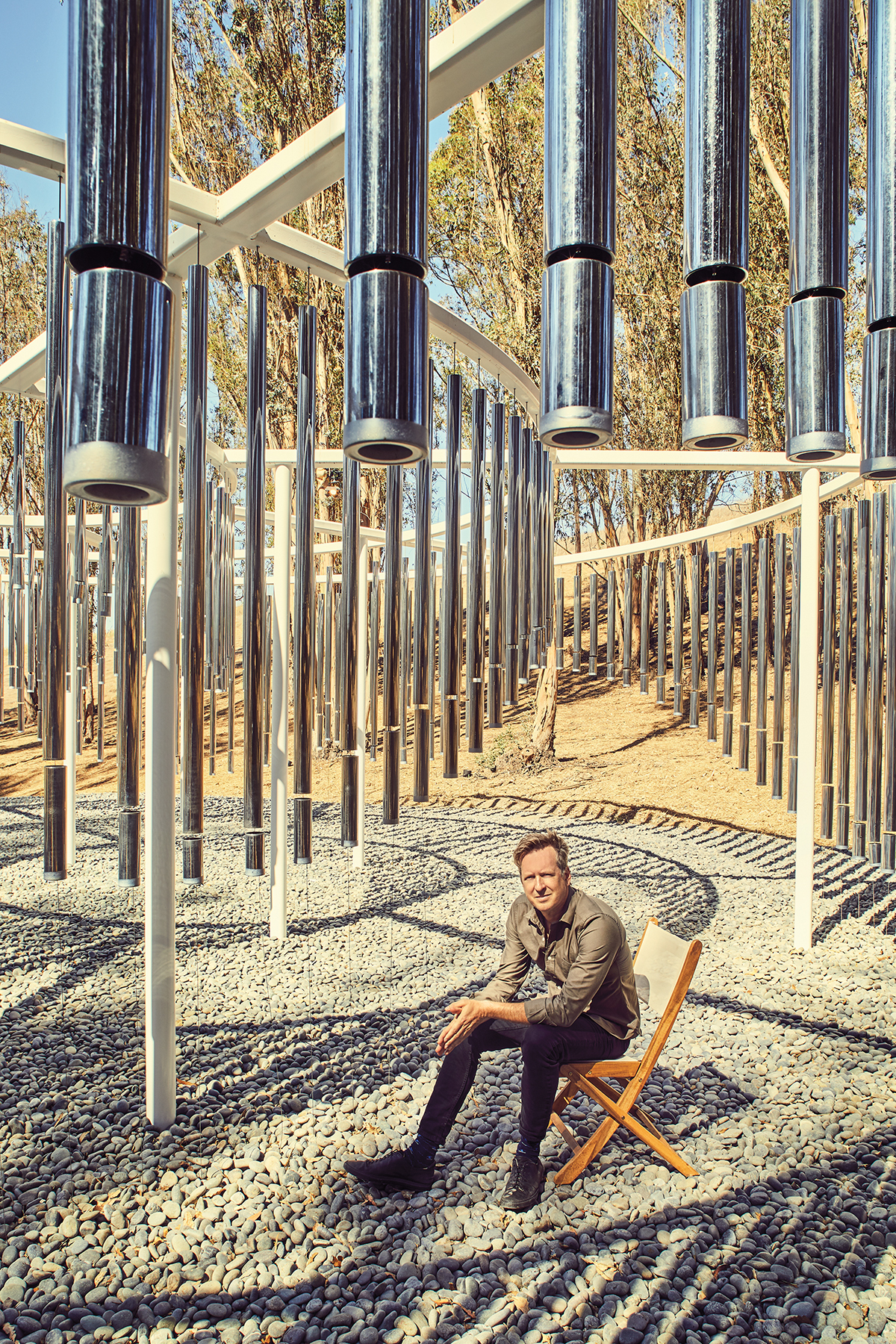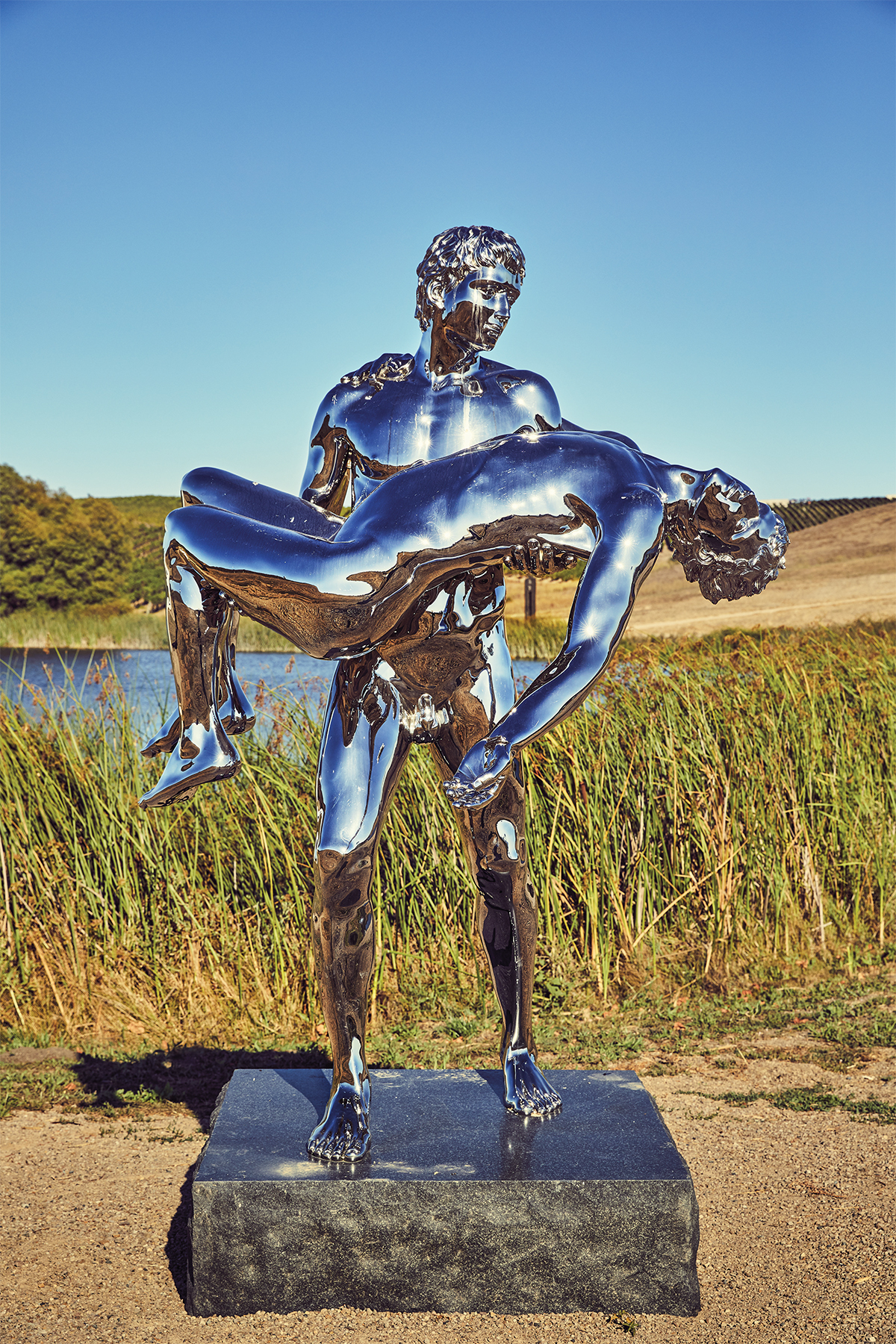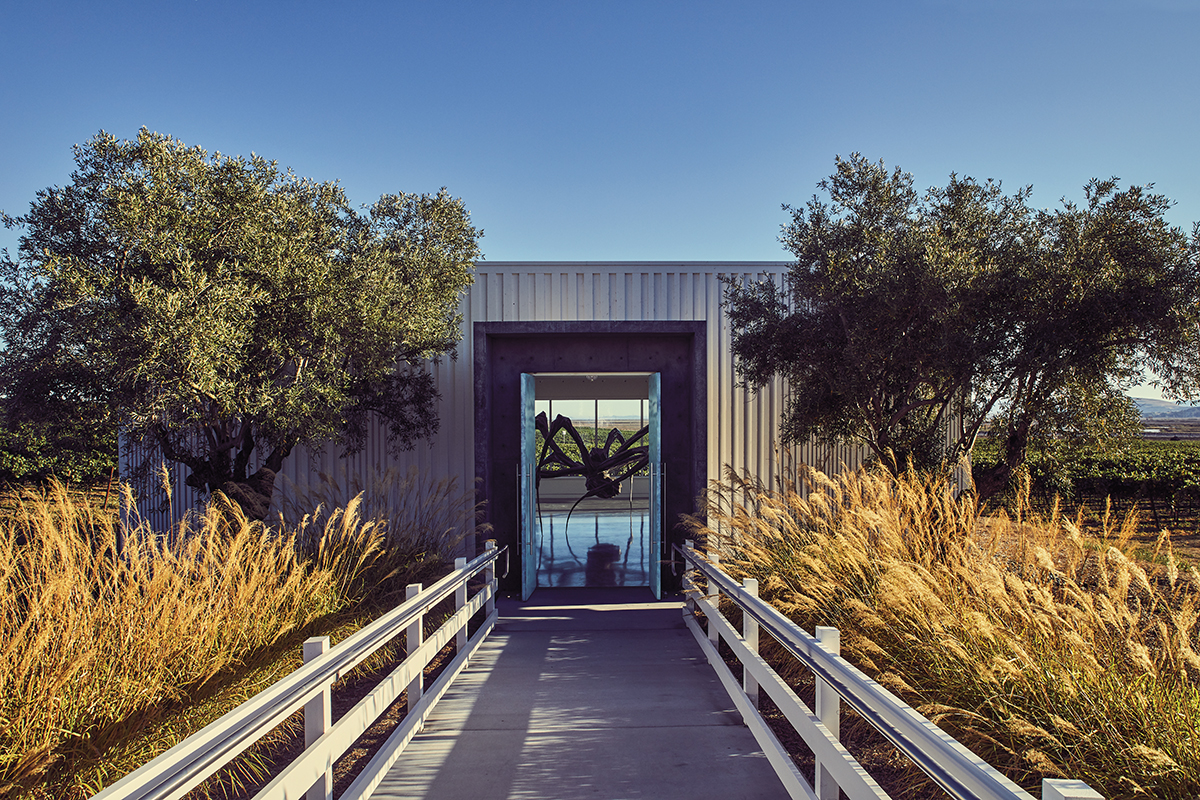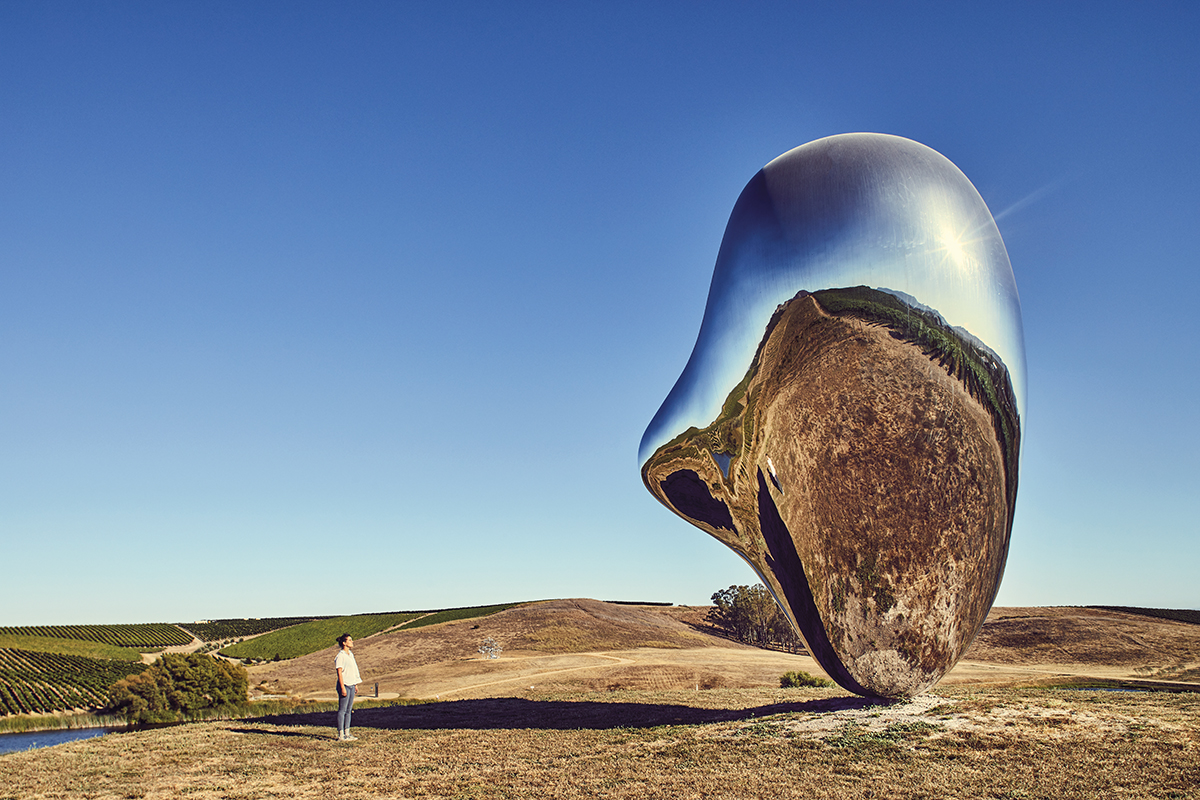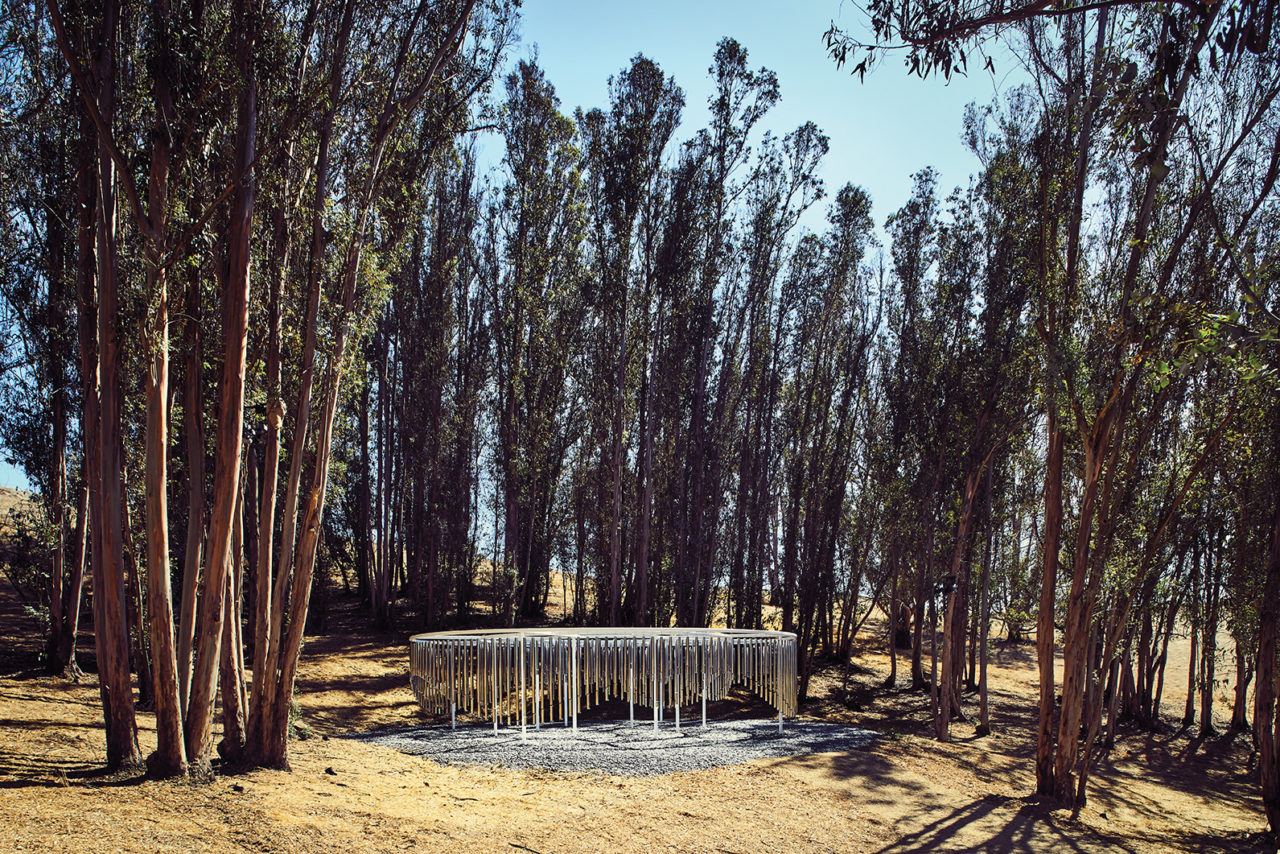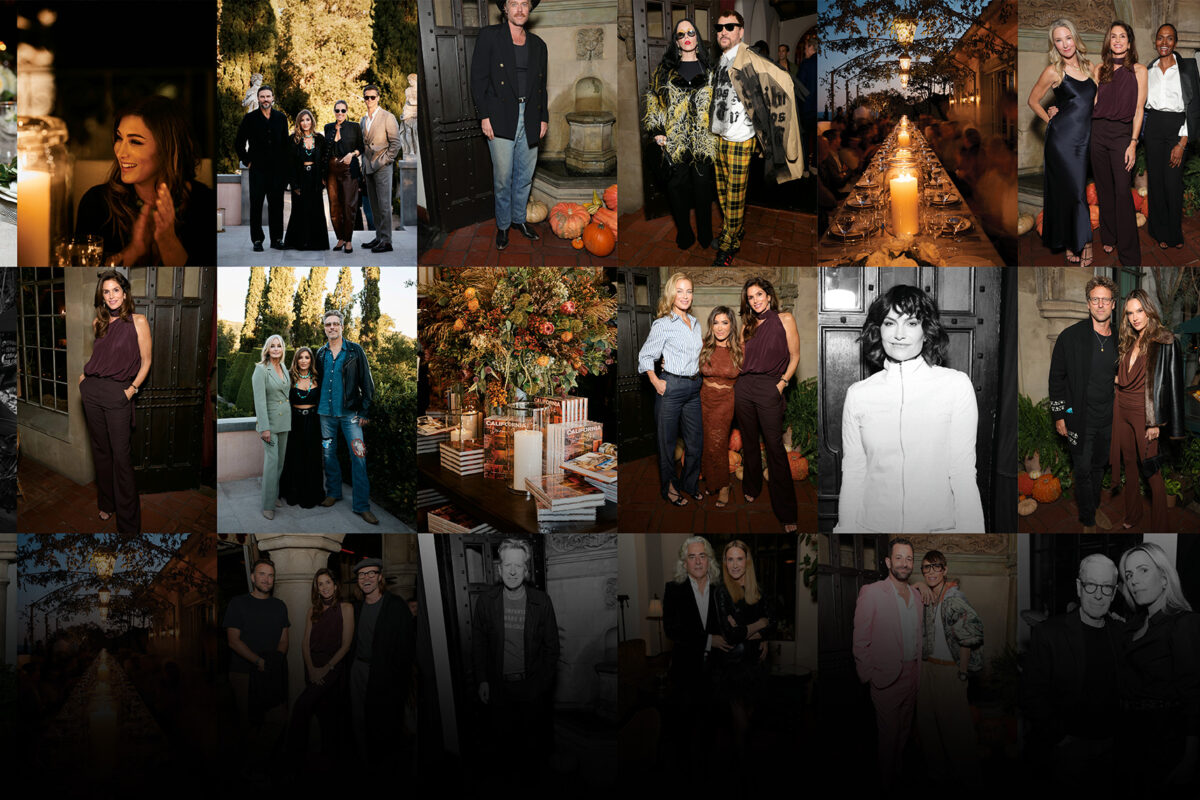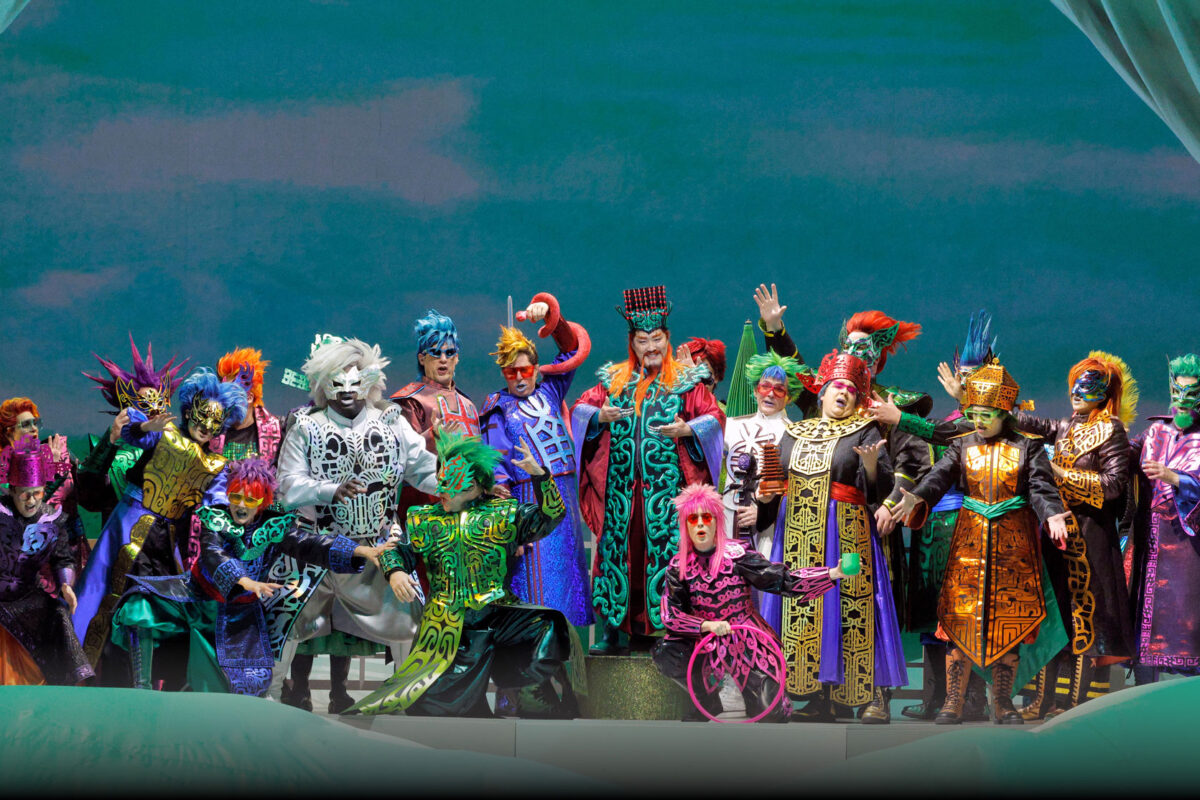Sonoma’s Donum Estate is the setting for the creative’s groundbreaking new performative sculpture
Words by ELIZABETH KHURI CHANDLER
Photography by SAM FROST
At dusk on a windy day in early September, 20 percussionists approached a lone eucalyptus grove on the sculpture-clotted vineyards of Donum Estate. Dressed all in white, the musicians began pounding their mallets on a shimmering labyrinth of hanging stainless steel pipes called Sonic Mountain (Sonoma), emitting sounds that were rhythmic and melodic, rapid yet mellow, much like an electronic beat at a nightclub. Then, after several minutes, the music faded into silence and the wind took over as the prime player of the sculptural instrument.
Artist Doug Aitken watched. He was here to see his newest work inaugurated with a composition by friend and previous collaborator Hisham Akira Bharoocha; and the result was startling. “I had never approached the sculpture like this before,” he says of walking up the hill toward it that night. “It was aggressive and hypnotic and powerful in this turbulent way. I was almost in a trance.”
That multisensory feeling is exactly what Donum Estate owners Allan Warburg, a Danish fashion businessman, and his wife, Mei Warburg, who was born in China, want people to experience at their winery and outdoor sculpture collection. The award-winning pinot noirs of Donum come first, but the couple is interested in creating something deeper. “Art in this setting is a different experience,” Allan says. “You look at a piece of art, you see it in this beautiful landscape, you listen to the birds … and then you have some beautiful wine; it becomes even more beautiful. We wanted to link all those experiences.”
“Art in this setting is a different experience”
Allan Warburg
The pair was introduced to Aitken through his 2017 Desert X piece Mirage, a mirrored house that reflected the arid Coachella Valley landscape, and also connected with him in Hong Kong. The Warburgs (who, with their two sons, divide their time between China, Denmark and now California) had begun collecting Chinese art and paintings in the early 2000s and purchased the well-known Donum Estate, a jewel-box winery located in the coveted Carneros tract, right after the 2008 financial crisis. “I bought the property because I knew the wine,” Allan says, hinting at its investment potential. “I thought that we would sell the business later.” But they fell in love with the beauty and peaceful quality of the property and now, he says with a low chuckle, “We’ll never sell it.”
Continuing to expand to reflect their diverse backgrounds, the couple’s collection now includes works from 20 countries across six continents. In 2014, they began placing sculptures throughout the topography of the winery and reworking the landscape to complement the artwork, bringing in plum trees, replanting others, draining various swampland and marveling at the results that came from manually reshaping the land.
Initially, the sculptures were purchased elsewhere and brought to the 200-acre property, such as Keith Haring’s King and Queen and Louise Bourgeois’ Crouching Spider (Mei’s favorite). Then the two started asking artists, many of whom are now friends, to select the locations for their site-specific commissions.
Today, tableaux of nearly 40 pieces are scattered across the property: Ghada Amer’s The Words I Love the Most, a bronze sphere made out of 100 different Arabic words for love, is set among lavender fields; Danh Vo’s We the People (detail), a reproduced fragment of the Statue of Liberty, lies among the pinot noir grapes. Barcelona native Jaume PIensa’s tranquil female face Sanna looks out over the crinkly golden and green waves of vines and hills. Other works by Michael Elmgreen and Ingar Dragset, Yayoi Kusama, Subodh Gupta, Richard Hudson and Tracey Emin make a simple stroll among the vines a surreal experience.
“I have this restlessness with static and stationary art”
Doug Aitken
Venice, Calif.-based Aitken was a logical fit from both the collectors’ and the artist’s perspective. “[Allan and Mei] shared this vision for something that was living and more performative,” says Aitken, whose work unifies different mediums and is often site-specific, from his living submerged architecture Underwater Pavilions on the ocean floor just off Catalina Island, to this past summer’s New Horizon, a series of happenings tied to a gleaming mirrored orb of a hot air balloon that traversed the East Coast. “I have this restlessness with static and stationary art,” he explains.
Aitken visited the site alone. “I found myself wandering away from the existing artworks,” he says, and gravitating toward the eucalyptus grove, where he was attracted to contours of the landscape. He was acutely aware of the sound in the grove, of the wind in the tall trees. “I asked myself, ‘How can we create an artwork that is not complacent — that is alive? An artwork that performs the landscape that it is provided with?’”
The answer was to construct an instrument. But from there it took nearly two years to execute the idea. Aitken found it challenging. “It was very interesting to figure out how to create a musical style that was kinetic and interesting and not too repetitive,” he says. The final result is based upon a series of visual patterns that come from 365 steel wind chimes of various lengths hanging in three concentric circles. “I wanted to create a kind of a glow or an aura, and everywhere you walk you would hear a radically different composition,” he says. “I wanted it to be something that every viewer would experience differently depending on the day, the hour and the minute.”
It’s all part of a diverse oeuvre for Aitken, whose proliferation of ideas shows no sign of stopping. He currently has a solo show in London (his first there in eight years) at Victoria Miro, on view through December. Meanwhile, Donum Estate is getting exposure as well. Previously only open to the public for by-appointment wine tastings, the estate will be offering art-only tours starting this fall. Also Donum, a new book that delves into the winery’s history and art collection, was released in October, and an educational outreach program is also in the works.
Meanwhile the grapes grow on, as the colorful structures watch over them. There is no comparable site in the United States that brings together taste and visual pleasure in this way. “It’s very interesting to see art occupying spaces outside of traditional architecture,” Aitken muses. “When you discover an artwork, you have to seek it out and find it. You have a sense of a journey and a destination. As a community, we want to discover. We want to author our own experiences.”
Feature image: A pondside shelter is flanked by ANSELM KIEFER’s warplane replica, “Mohn und Gedächtnis (Poppy and Memory),” and RICHARD HUDSON’s hilltop heart sculpture.
This story originally appeared in the November 2019 issue of C Magazine.
Discover more CULTURE news.


